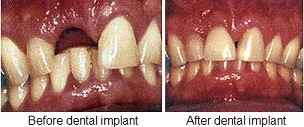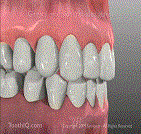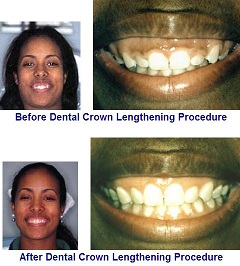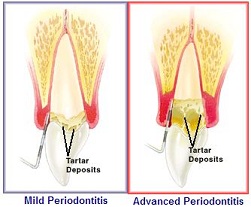General Information
According to American Academy of Periodontology
What can dental implants offer you?
- Replace one or more teeth without affecting the teeth next to it.
- Support a bridge and eliminate the need for partial dentures.
- Improve the way your denture fits in the mouth by providing additional support.
Missing teeth
- Missing teeth are causing gaps in your smile and can change the way you eat, function and smile.
- Dental Implants are one way of filling the gaps and give you another set of teeth.
- They are a closer natural looking alternative to dentures or bridges.
- They restore the loss function giving you confidence to smile, eat and talk like before losing your teeth.

Are you a candidate for implants?
- Good general and oral health gives you better chances of success with Dental implants.
- Smoking is not a contraindication but downgrades your success.
When can I start?
- Placing and restoring dental implants is a team effort involving the patient, his general dentist and the periodontist.
- Great results require successful communication and clear understanding of the procedure and the steps involved.
- Upon your first appointment you'll receive a comprehensive assessment of your oral health.
Laser treatment of periodontal disease
-
In recent years laser treatment in Dentistry became a viable alternative for many traditional procedures, making the treatments less painful, more precise with faster healing.
FDA cleared lasers and found them safe for public usage in 1990.
-
Since then many offices incorporated lasers into everyday procedures reducing bleeding, anxiety, post treatment healing time.
Some of the benefits associated with lasers:
- Faster healing
- Tissue regeneration
- Reduced need for sutures
- Reduced bleeding during and after treatment
- Reduce risk of bacterial infection after surgeries
- Less discomfort
In recent years, laser dentistry has superseded many traditional dentistry practices, making treatments more precise and less painful. This newer style of dentistry utilizes intense beams of light projected by a dental laser. Dental lasers can be used to perform a wide variety of treatments, including soft tissue shaping and removal.
The FDA deemed laser dentistry to be safe for public usage in 1990. Since then, many dentists have incorporated dental lasers into everyday procedures - reducing bleeding, anxiety and post-treatment recovery times. The beauty of dental lasers is that they damage far less of the surrounding tissue than traditional techniques - which means less discomfort and pain.
What is Sedation Dentistry?
IV Sedation is strongly recommended if you are in good overall health and:
- Have fear associated with the dental office.
- Had not very pleasant dental experiences in the past
- Need a complex, difficult or long surgical procedure like dental implants, extractions or periodontal surgery
- Have a strong gag reflex
- Have a very difficult time getting numb
- Desire to have more procedures done in a few number of appointments
NON-SURGICAL PERIODONTAL TREATMENT
Gingivitis is the mildest form of periodontal disease.
It causes the gums to become red, swollen, and bleed easily.
There is usually little or no discomfort at this stage. Gingivitis is often caused by inadequate oral hygiene.
Gingivitis is reversible with professional treatment and good oral home care.
Factors that may contribute to gingivitis include, diabetes, smoking, aging, genetic predisposition, systemic diseases and conditions,
stress, inadequate nutrition, puberty, hormonal fluctuations, pregnancy, substance abuse, HIV infection, and certain medication use.
GUM GRAFT SURGERY
Exposed tooth roots are the result of gum recession. Gum graft surgery will repair the defect and help to prevent additional recession and bone loss.
 Gum grafts can be used to cover roots or develop gum tissue where absent due to excessive gingival recession.
During gum graft surgery, your periodontist takes gum tissue from your palate or another donor source to cover the exposed root.
This can be done for one tooth or several teeth to even your gum line and reduce sensitivity.
Gum grafts can be used to cover roots or develop gum tissue where absent due to excessive gingival recession.
During gum graft surgery, your periodontist takes gum tissue from your palate or another donor source to cover the exposed root.
This can be done for one tooth or several teeth to even your gum line and reduce sensitivity.
WHAT ARE THE BENEFITS OF GUM GRAFT SURGERY?
A gum graft can reduce further recession and bone loss.
In some cases, it can cover exposed roots to protect them from decay.
This may reduce tooth sensitivity and improve esthetics of your smile.
Whether you have a gum graft to improve function or esthetics, patients often receive the benefits of both:
a beautiful new smile and improved periodontal health - your keys to smiling, eating and speaking with comfort and confidence.
Regenerative Procedures
Pocedures that regenerate lost bone and tissue supporting your teeth can reverse some of the damage caused by periodontal disease.
Your periodontist may recommend a regenerative procedure when the bone supporting your teeth has been destroyed due to periodontal disease.
These procedures can reverse some of the damage by regenerating lost bone and tissue.
During this procedure, your periodontist folds back the gum tissue and removes the disease-causing bacteria.
Membranes (filters), bone grafts or tissue-stimulating proteins can be used to encourage your body's natural ability to regenerate bone and tissue.
Eliminating existing bacteria and regenerating bone and tissue helps to reduce pocket depth and repair damage caused by the progression of periodontal disease. With a combination of daily oral hygiene and professional maintenance care,
you'll increase the chances of keeping your natural teeth - and decrease the chances of other health problems associated with periodontal disease.
Dental Crown Lengthening
You may have asked your periodontist about procedures to improve a "gummy" smile because your teeth appear short. Your teeth may actually be the proper lengths, but they're covered with too much gum tissue.
To correct this, your periodontist performs a dental crown lengthening procedure.
 During the dental crown lengthening procedure, excess gum and bone tissue is reshaped to expose more of the natural tooth.
This can be done to one tooth, to even your gum line, or to several teeth to expose a natural, broad smile.
f
Your dentist or periodontist may also recommend dental crown lengthening to make a restorative or cosmetic dental procedure possible. Perhaps your tooth is decayed, broken below the gum line, or has insufficient tooth structure for a restoration, such as a crown or bridge.
Crown lengthening adjusts the gum and bone level to expose more of the tooth so it can be restored.
During the dental crown lengthening procedure, excess gum and bone tissue is reshaped to expose more of the natural tooth.
This can be done to one tooth, to even your gum line, or to several teeth to expose a natural, broad smile.
f
Your dentist or periodontist may also recommend dental crown lengthening to make a restorative or cosmetic dental procedure possible. Perhaps your tooth is decayed, broken below the gum line, or has insufficient tooth structure for a restoration, such as a crown or bridge.
Crown lengthening adjusts the gum and bone level to expose more of the tooth so it can be restored.
PLASTIC SURGERY PROCEDURES
Periodontists are often considered the plastic surgeons of dentistry.
If you are looking to improve your smile, a periodontist may be able to help.
GUMMY SMILE OR UNEVEN GUM LINE
Do you feel your teeth look too short and your smile is too gummy or your gums cover too much of some teeth while leaving the others the right length?
If so, dental crown lengthening might be the solution for you.
During this procedure, excess gum tissue is removed to expose more of the crown of the tooth.
Then your gumline is sculpted to give your new smile just the right look.
LONG TEETH/EXPOSED ROOTS
Sometimes gum recession causes the tooth root to become exposed,
which makes your teeth look long and can make you look older than you are.
This recession can happen as a result of a variety of causes, including periodontal diseases.
Gum graft surgery and other root coverage procedures are designed to cover exposed roots,
to reduce further gum recession and to protect vulnerable roots from decay.
INDENTATIONS IN THE GUMS AND JAWBONE
Tooth loss can cause an indentation in the gums and jawbone where the tooth used to be.
This happens because the jawbone recedes when it no longer is holding a tooth in place.
Not only is this indention unnatural looking, it also causes the replacement tooth to look too long compared to the adjacent teeth.
Ridge augmentation can fill in this defect recapturing the natural contour of the gums and jaw.
A new tooth can then be created that is natural looking, easy to clean and beautiful.
Periodontal Pocket Reduction Procedures
Your bone and gum tissue should fit snugly around your teeth like a turtleneck around your neck.
When you have periodontal disease, this supporting tissue and bone is destroyed, forming "pockets" around the teeth.
Over time, these pockets become deeper, providing a larger space for bacteria to live.
As bacteria develop around the teeth, they can accumulate and advance under the gum tissue.
These deep pockets collect even more bacteria, resulting in further bone and tissue loss.
Eventually, if too much bone is lost, the teeth will need to be extracted.
 Your periodontist has measured the depth of your pocket(s).
A periodontal pocket reduction procedure has been recommended because you have pockets that are too deep
to clean with daily at-home oral hygiene and a professional care routine.
During this procedure, your periodontist folds back the gum tissue and removes the disease-causing bacteria before securing the tissue into
place.
In some cases, irregular surfaces of the damaged bone are smoothed to limit areas where disease-causing bacteria can hide.
This allows the gum tissue to better reattach to healthy bone.
Reducing pocket depth and eliminating existing bacteria are important to prevent damage caused by the progression
of periodontal disease and to help you maintain a healthy smile.
Eliminating bacteria alone may not be sufficient to prevent disease recurrence.
Deeper pockets are more difficult for you and your dental care professional to clean, so it's important for you to reduce them.
Reduced pockets and a combination of daily oral hygiene and professional maintenance care increase your chances of keeping your natural
teeth - and decrease the chance of serious health problems associated with periodontal disease.
Your periodontist has measured the depth of your pocket(s).
A periodontal pocket reduction procedure has been recommended because you have pockets that are too deep
to clean with daily at-home oral hygiene and a professional care routine.
During this procedure, your periodontist folds back the gum tissue and removes the disease-causing bacteria before securing the tissue into
place.
In some cases, irregular surfaces of the damaged bone are smoothed to limit areas where disease-causing bacteria can hide.
This allows the gum tissue to better reattach to healthy bone.
Reducing pocket depth and eliminating existing bacteria are important to prevent damage caused by the progression
of periodontal disease and to help you maintain a healthy smile.
Eliminating bacteria alone may not be sufficient to prevent disease recurrence.
Deeper pockets are more difficult for you and your dental care professional to clean, so it's important for you to reduce them.
Reduced pockets and a combination of daily oral hygiene and professional maintenance care increase your chances of keeping your natural
teeth - and decrease the chance of serious health problems associated with periodontal disease.

 Gum grafts can be used to cover roots or develop gum tissue where absent due to excessive gingival recession.
During gum graft surgery, your periodontist takes gum tissue from your palate or another donor source to cover the exposed root.
This can be done for one tooth or several teeth to even your gum line and reduce sensitivity.
Gum grafts can be used to cover roots or develop gum tissue where absent due to excessive gingival recession.
During gum graft surgery, your periodontist takes gum tissue from your palate or another donor source to cover the exposed root.
This can be done for one tooth or several teeth to even your gum line and reduce sensitivity.


